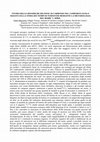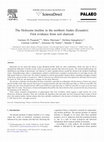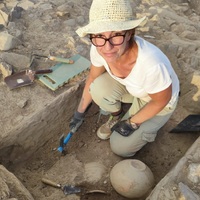Papers by carmine lubritto
In the framework of the activities of the Department of Environmental Sciences within the Compete... more In the framework of the activities of the Department of Environmental Sciences within the Competence Center INNOVA, a new integrated laboratory has been established in isotopic research applied to the study of the cultural and environmental heritage. At present the laboratory includes ...

Quaternary International, 2011
Detailed mapping of Holocene shorelines outcropping a few meters above the present sea-level at C... more Detailed mapping of Holocene shorelines outcropping a few meters above the present sea-level at Capo Milazzo, the main headland of NE Sicily, supplied evidence of the interplay between abrupt and steady uplift. Field analysis revealed two shorelines at distinct elevations, which were characterized through position and radiometric dating of geomorphologic and biological sea-level markers. The upper shoreline is represented by a notch, marine deposits and barnacle rims. The notch is found at average elevation of w2.1 m above mean sea level (a.m.s.l.) and is filled by a marine deposit containing shells dated between 6.2 and 3.9 ka BP. Locally, the deposit includes pottery of Roman age (w2 ka BP). An intertidal balanid rim associated with the upper shoreline yielded ages between 3.8 and 1.6 ka BP. The lower shoreline involves a notch at w0.8 m a.m.s.l., locally carved in the older Holocene deposit, and a likely coeval, subjacent abrasion platform at 0.5e0.6 m a.m.s.l. Remains of a balanid rim in this lower notch were dated at w1.4 ka BP. Morphological and chronostratigraphical relations indicate that uplift of the upper shoreline occurred abruptly. Sudden displacement of 1.3e1.5 m occurred during a co-seismic event. Age and elevation relationships document that the upper shoreline was active between 6.2 and 1.6 ka, and thus co-seismic uplift must have occurred between 1.6 and w1.4 ka, the bracketed ages of cessation and inception of the upper and lower shorelines, respectively. Using similar reasoning, a younger (w0.8e0.9 m) co-seismic uplift occurred probably shortly after 1.4 ka. These uplifts supplemented a regional, background uplift that operated steadily during the lifespan of the two shorelines. Precise compensation for the glacio-hydro-isostatic sea-level change indicated that this uplift took place at w0.65 mm/y. Thus, cumulative uplift at the studied sites occurred at 1.2e1.5 (locally up to 2.1) mm/y, in close agreement with nearby coastal sites in Sicily and southern Calabria. Analysis suggests the occurrence of a seismogenic source in the Capo Milazzo area, possibly related to transpressive structures recently mapped offshore. The seismogenic potential of this sector of Sicily needs to be re-evaluated.

Global and Planetary Change, 2016
We present a high-resolution paleoclimatic and paleoenvironmental reconstruction of the last five... more We present a high-resolution paleoclimatic and paleoenvironmental reconstruction of the last five millennia from a shallow water marine sedimentary record from the central Tyrrhenian Sea (Gulf of Gaeta) using planktonic forami-nifera, pollen, oxygen stable isotope, tephrostratigrapy and magnetostratigrapy. This multiproxy approach allows to evidence and characterize nine time intervals associated with archaeological/cultural periods: Eneolithic (base of the core–ca. 2410 BCE), Early Bronze Age (ca. 2410 BCE–ca. 1900 BCE), Middle Bronze Age–Iron Age (ca. 1900 BCE–ca. 500 BCE), Roman Period (ca. 500 BCE–ca. 550 CE), Dark Age (ca. 550 CE–ca. 860 CE), Medieval Climate Anomaly (ca. 860 CE–ca. 1250 CE), Little Ice Age (ca. 1250 CE–ca. 1850 CE), Industrial Period (ca. 1850 CE–ca. 1950 CE), Modern Warm Period (ca. 1950 CE–present day). The reconstructed climatic evolution in the investigated sedimentary succession is coherent with the short-term climate variability documented at the Mediterranean scale. By integrating the planktonic foraminiferal turnover from carnivorous to herbivorous–opportunistic species, the oxygen isotope record and the pollen distribution, we document important modification from the onset of the Roman Period to the present-day. From ca. 500 CE upwards the documentation of the cooling trend punctuated by climate variability at secular scale evidenced by the short-term δ 18 O is very detailed. We hypothesise that the present day warm conditions started from the end of cold Maunder event. Additionally, we provide that the North Atlantic Oscillation (NAO) directly affected the central Mediterranean region during the investigated time interval.
Physics Letters A, 1998
ELSEVIER Physics Letters A 239 (1998) 307312 9 March 1998 PHYSICS LETTERS A Chiral boson field th... more ELSEVIER Physics Letters A 239 (1998) 307312 9 March 1998 PHYSICS LETTERS A Chiral boson field theory for neutral and charged edge excitations of Laughlin liquids in smooth confining potentials Sergio De Filippo a,b,1, Carmine Lubritto a,ca Dipartimento di Scienze Fisiche, ...
Physica B: Condensed Matter, 1997
Using Haldane's spherical model, new microscopic trial wave functions originally built on di... more Using Haldane's spherical model, new microscopic trial wave functions originally built on disk geometry are mapped onto the sphere. These wave functions were obtained for arbitrary fractional filling by adiabatic interpolation through anyon Hamiltonians. Monte ...
Munibe Antropologia Arkeologia, 2009
1-INTRODUCTION In the last few years the isotopic methodolo-gies plaid a role more and more impor... more 1-INTRODUCTION In the last few years the isotopic methodolo-gies plaid a role more and more important both in interdisciplinary and applied researches, and in a growing number of analysis and control procedu-res in industrial, environmental, biomedical, archaeometry and ...
The 3He(α, Γ)7Be reaction plays an important role in the interpretation of the results of the sol... more The 3He(α, Γ)7Be reaction plays an important role in the interpretation of the results of the solar neutrino experiments, since the estimate of the oscillation parameters relies on the solar neutrino spectrum, calculated by solar models. The high energy component in this spectrum is mainly produced by the decay of 7Be and 8B. The uncertainty in the 3He(α, Γ)7Be cross

Trees, 2015
Key message Variations in stable carbon and oxygen isotope compositions of co-occurring plant spe... more Key message Variations in stable carbon and oxygen isotope compositions of co-occurring plant species reflect their different water use strategies and indicate the importance of screening species' WUE i to plan climate change adaptation strategies. Abstract The different abilities of plant species to cope with drought have been associated with structural and ecophysiological constraints. In this paper, we evaluate interspecific differences in intrinsic water use efficiency (WUE i ) and the ratio of photosynthesis (A) to stomatal conductance (g s ) in three co-occurring Mediterranean shrubs: two broad-leaved evergreen (Pistacia lentiscus and Phillyrea angustifolia) and one needle-like-leaved evergreen (Juniperus phoenicea). We used d 13 C in rings to assess inter-annual changes in WUE i while the influence of the stomatal conductance was explored through d 18 O. Our results indicate consistent differences in WUE i in the three species, largely determined by leaf traits and differences in stomatal conductance control. Juniperus phoenicea could be the most threatened by the current trend of increasing temperature and summers drought. Phillyrea angustifolia and P. lentiscus seem to be less affected by drought stress because of their tighter stomatal control and high survival rate under field conditions. Our study shows that shrubs with different leaf traits employ different plant ecophysiological strategies under drought stress.
Negli ultimi anni, si sono sviluppate differenti metodologie archeometriche, capaci di effettuare... more Negli ultimi anni, si sono sviluppate differenti metodologie archeometriche, capaci di effettuare datazioni su reperti provenienti da differenti siti archeologici, in particolare per ricostruire ed identificare differenti culture che si sono succedute in Italia in millenni attraverso una ...

Gli impatti antropici, mediante il rilascio di una grande quantità di CO 2 ed il cambiamento dell... more Gli impatti antropici, mediante il rilascio di una grande quantità di CO 2 ed il cambiamento delle naturali destinazioni d'uso dei suoli, stanno drasticamente alterando il ciclo del carbonio. La concentrazione di CO 2 in atmosfera, un indicatore molto sensibile dell'impatto di queste azioni, è cresciuta negli ultimi due secoli di circa 200 mol mol μ raddoppiando la sua concentrazione iniziale. L'attuale concentrazione di anidride carbonica in atmosfera non è stata mai superata o raggiunta negli ultimi 420000 anni (IPCC, 2001). Un ruolo importante nel bilanciamento delle emissioni antropiche di CO 2 in atmosfera è ricoperto dalle altre due maggiori riserve di carbonio che prendono parte al ciclo: gli oceani e le terre emerse. Per gli ecosistemi terrestri, con tempi di rilascio nella scala decennale, un terzo del carbonio totale è parte della biomassa vivente ed il resto (due volte il carbonio attualmente contenuto nell'atmosfera (Schlesinger,1995)) è parte integrante ...

In previous papers we pointed out how the "Power Saving" method can be usefully used to lower the... more In previous papers we pointed out how the "Power Saving" method can be usefully used to lower the energy consumption of a base transceiver station (BTS). It consists in switching off the redundant channels during low traffic periods that can occur during the day or week. However, this saving should be pursued with minimum or no losses in terms of the quality of the service provided to the final user; a parameter to trace is the number of lost calls for the lack of available channels. For example, the switching off of the unneeded channels should occur when the fluctuation of the number of calls and their lengths permit to foresee a quite long period of low demand. Moreover, the channel control algorithm should be adequately smart to address a coming high demand period, providing a fast activation of the needed channels. This is obtained with a control algorithm and with a fine tuning of its parameters. In this paper we test the control algorithm with Monte Carlo simulations. Then we check the algorithm for the best numerical and BTS parameters finding the range of savings that can be obtained for standard cases. Finally, we apply the code to the behaviour of a prototypal BTSs under a wide range of loads so it is possible to check the best parameters giving the maximum power saving while still safeguarding good communication levels. Data coming from a recent auditing of Italian BTSs (number of calls, calls length, maximum number of possible call and other BTS parameters) and from in situ measurements, are used as tuning parameters. We show that considerable savings in the power consumptions are possible, depending on the characteristics of the site, without loss of service quality.
Three 13 C-depleted leaf litter (Liquidambar styraciflua L., Cercis Canadensis L. and Pinus taeda... more Three 13 C-depleted leaf litter (Liquidambar styraciflua L., Cercis Canadensis L. and Pinus taeda L.) were incubated in jars on a C4 soil under laboratory controlled conditions. Four jars containing only soil were established as control. Litter chemical properties were measured using ...
Tre specie di foglie (Liquidambar styraciflua L., Cercis Canadensis L. and Pinus taeda L.) deplet... more Tre specie di foglie (Liquidambar styraciflua L., Cercis Canadensis L. and Pinus taeda L.) deplete in 13 C sono state incubate in condizioni di laboratorio controllate. Quattro barattoli contenenti solo suolo sono stati usati come sistemi controllo. Le proprietà chimiche della lettiera ...

Despite litter decomposition is one of the major process controlling soil C stores and nutrient c... more Despite litter decomposition is one of the major process controlling soil C stores and nutrient cycling, yet C dynamics during litter decay are poorly understood and quantified. Here we report the results of a laboratory experiment where 13C depleted leaf litter was incubated on a 13C enriched soil with the aims to: i) partition the C loss during litter decay into microbial respired-CO2 and C input into the soil; ii) identify the soil compounds where litter derived C is retained; iii) assess whether litter quality is a determinant of both the above processes. Three 13C-depleted leaf litter(delta13C ca. -43), differing in their degradability, were incubated on C4 soil (delta13C ca. -18) under laboratory controlled conditions for 8 months, with litter respiration and delta13C-CO2 being measured at regular intervals. At harvest, Compound Specific Isotope Analyses was performed on soil and litter samples in order to follow the fate of litter-derived C compounds in the various pools of S...

Indications for the speed and timing of past altitudinal treeline shifts are often contradictory.... more Indications for the speed and timing of past altitudinal treeline shifts are often contradictory. Partly, this may be due to interpretation difficulties of pollen records, which are generally regional rather than local proxies. We used pedoanthracology, the identification and dating of macroscopic soil charcoal, to study vegetation history around the treeline in the northern Ecuadorian Andes. Pedoanthracology offers a complementary method to pollen-based vegetation reconstructions by providing records with high spatial detail on a local scale. The modern vegetation is tussock grass páramo (tropical alpine vegetation) and upper montane cloud forest, and the treeline is located at ca. 3600 m. Charcoal was collected from soils in the páramo (at 3890 and 3810 m) and in the forest (at 3540 m), and represents a sequence for the entire Holocene. The presence of páramo taxa throughout all three soil profiles, especially in combination with the absence of forest taxa, shows that the treeline in the study area has moved up to its present position only late in the Holocene (after ca. 5850 cal years BP). The treeline may have been situated between 3600 m and 3800 m at some time after ca. 4900 cal years BP, or it may never have been higher than it is today. The presence of charcoal throughout the profiles also shows that fires have occurred in this area at least since the beginning of the Holocene. These results contradict interpretations of palaeological data from Colombia, which suggest a rapid treeline rise at the Pleistocene–Holocene transition. They also contradict the hypothesis that man-made fires have destroyed large extents of forest above the modern treeline. Instead, páramo fires have probably contributed to the slowness of treeline rise during the Holocene.
Nuovo Cimento D Serie, May 1, 1998
Radioactivity was found to be very high in tuff and other materials originating from volcanic lav... more Radioactivity was found to be very high in tuff and other materials originating from volcanic lava. Emanation of radon from such materials is appreciably higher than from materials of other origin. This work allowed us to obtain a first complete database of natural radioactivity concentrations in building materials from this region. Measurements were carried out by means of a gamma spectrometry system. Gamma emitting daughter products of 222Rn were measured to determine 226Ra. The samples, after a routine treatment, were accommodated in sealed metallic containers for a time sufficient for the equilibrium to establish. The determination of the radon emanation power was carried out by using an electrostatic monitor. Alpha spectroscopy of radon daughters was used to evaluate the content of radon coming from the sample
The age of a fragment of the Epicurus “De Natura” papyrus has been measured, for the first time, ... more The age of a fragment of the Epicurus “De Natura” papyrus has been measured, for the first time, by means of the 14C AMS technique, a non- or micro-destructive analytical technique. A radiocarbon age of 2275±80 yr BP was obtained. This result is coherent with palaeographic studies which had given a date between the end of the 3rd and the beginning of the 2rd century B.C.








Uploads
Papers by carmine lubritto